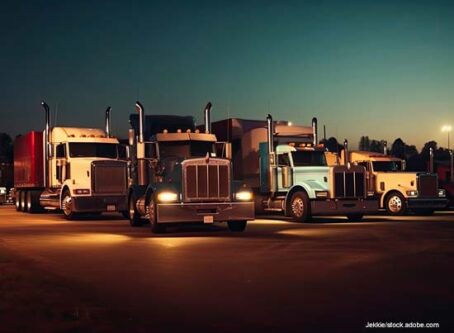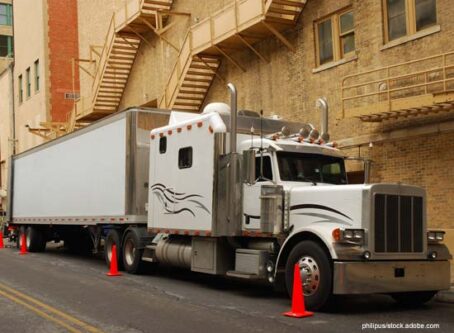Trucking facts roundup
Every year at summer’s end, monthly magazine Heavy Duty Trucking publishes an issue it calls its Fact Book – a collection of statistics gleaned from numerous sources. About the same time, Transport Topics, the weekly publication of the American Trucking Associations, publishes its Top 100 lists of for-hire carriers and private fleets. Here are a few interesting items from each.
- A tiny number of mega carriers operate the largest portion of for-hire trucks on the highways. The largest share of actual trucks, 36% of the for-hire total, belongs to mega carrier fleets of more than 500 trucks. Yet mega carriers represent just one-tenth of one percent of all for-hire trucking businesses. Even though almost half of all for-hire trucking businesses are one-truck operations, those trucks comprise only 5% of all the for-hire trucks on the highways. The balance of for-hire trucks belongs to fleets of two to 499 trucks, according to the FMCSA.
- Driver wages represent 32% of trucking costs per mile, according to 2019 figures from the ATA’s American Transportation Research Institute. Driver benefits are another 10%. Fuel makes up 24%, truck payments 16%, maintenance 9%, insurance 4%, and permits and licenses 1% of costs. Tolls and tires represent 2% each.
-
According to the HDT/Work Truck Safety Survey, the location of the most crashes – 31% – is in parking lots.
- The best-paying driving jobs are in New York, New Jersey, Massachusetts, Connecticut, and Indiana east of the Mississippi, according to the Bureau of Labor Statistics. On average, those jobs pay from $51,400 to $59,700 a year. West of the Mississippi, those better-paying jobs are in California, Washington, Nevada, Wyoming, Colorado, North Dakota and Oklahoma. The lowest-paying jobs – paying from $21,500 to $45,540 – are in Idaho, New Mexico, Iowa and Louisiana west of the Mississippi. East of the big river those jobs are in Mississippi, Alabama, Florida, South Carolina and Maine.
- Almost 60% of fleets offer sign-on bonuses. Those bonuses average $3,242 according to the National Transportation Institute.
- The percentage of women truck drivers has grown from 4.6% in 2010 to 7.8% in 2020, says the Bureau of Labor Statistics.
- According to ACT Research, used truck prices hit an average of $58,600 in April. ACT expects 2021 prices to end up 20% to 30% higher than 2020 prices on average.
- ACT Research expects the proportion of battery-electric Class 4 through 8 trucks will more than double from 1% this year to 3% in 2022, then triple to 9% in 2024. The company anticipates that number will grow to 43% by 2040.
- Flatbed drivers average the longest turnaround times compared to refrigerated and dry-van drivers according to TruckStop.com. Flatbed drivers wait an average of 13 hours from the time they deliver one load until they find another. That’s down significantly from 2019, when flatbed turnaround time averaged more than 18 hours. By comparison, refrigerated and dry-van drivers averaged more than 13 hours in 2019. In 2021, dry-van drivers wait approximately 10.5 hours.
-
Reefer drivers experienced the greatest change from 13 hours in 2019 to less than eight hours in 2021.
- According to Transport Topics, North America’s largest for-hire carriers by gross revenue for 2021 are UPS, FedEx and XPO Logistics, in that order. Number four on the list and the biggest carrier in the truckload category – again, by revenue – is J.B. Hunt Transport. That includes Hunt’s substantial intermodal operation for a total of 17,777 tractors. Fifth on the list is TFI International, a Canadian holding company with 12 LTL, eight truckload, and four package/courier fleets – a total of 24 carriers. TFI’s truckload carriers include familiar names like CFI and Transport America. TFI’s LTL carriers include TForce Freight, the name the company gave UPS Freight when it bought that operation from UPS last year. Altogether, TFI operates 24,600 power units.
- Of Transport Topics’ Top 100 Private Carriers, the largest is Pepsico, which includes Pepsi Beverages, Frito Lay and Quaker Foods. Altogether, Pepsico operates almost 11,000 tractors, 4,600 straight trucks, and more than 16,000 cargo vans and pickups. Number two is Sysco, the restaurant and institutional food supplier that includes The Sygma Network, among other operating divisions. Sysco fields 8,745 tractors. Third is Walmart, which operates 7,400 tractors. Walmart owns 58,826 trailers. Only Fedex with 132,500 and UPS with almost 88,000 have more trailers than Walmart – though Knight Swift comes close with 57,722. LL
More trucking facts and statistics in Land Line:
- Bureau of Transportation Statistics to relaunch Vehicle Inventory and Use Survey.
- Driver turnover: the stark reality behind the statistics.
- Lies, damned lies and statistics.









